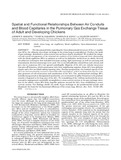| dc.contributor.author | Makanya, AN | |
| dc.contributor.author | El-Darawish, Y | |
| dc.contributor.author | Kavoi, BM | |
| dc.contributor.author | Djonov, V | |
| dc.date.accessioned | 2013-06-28T06:12:43Z | |
| dc.date.available | 2013-06-28T06:12:43Z | |
| dc.date.issued | 2011 | |
| dc.identifier.citation | Microscopy Research and Technique Volume 74, Issue 2, pages 159–169, February 2011 | en |
| dc.identifier.uri | http://onlinelibrary.wiley.com/doi/10.1002/jemt.20887/abstract;jsessionid=00D8E883D9AA5125551B56FE020A49C7.d01t02?deniedAccessCustomisedMessage=&userIsAuthenticated=false | |
| dc.identifier.uri | http://erepository.uonbi.ac.ke:8080/xmlui/handle/123456789/41370 | |
| dc.description.abstract | The documented data regarding the three-dimensional structure of the air capillaries (ACs), the ultimate sites of gas exchange in the avian lung is contradictory. Further, the mode of gas exchange, described as cross-current has not been clearly elucidated. We studied the temporal and spatial arrangement of the terminal air conduits of the chicken lung and their relationship with the blood capillaries (BCs) in embryos as well as the definitive architecture in adults. Several visualization techniques that included corrosion casting, light microscopy as well as scanning and transmission electron microscopy were used. Two to six infundibulae extend from each atrium and give rise to numerous ACs that spread centrifugally. Majority of the ACs are tubular structures that give off branches, which anastomose with their neighboring cognates. Some ACs have globular shapes and a few are blind-ending tapering tubes. During inauguration, the luminal aspects of the ACs are characterized by numerous microvillus-like microplicae, which are formed during the complex processes of cell attenuation and canalization of the ACs. The parabronchial exchange BCs, initially inaugurated as disorganized meshworks, are reoriented via pillar formation to lie predominantly orthogonal to the long axes of the ACs. The remodeling of the retiform meshworks by intussusceptive angiogenesis essentially accomplishes a cross-current system at the gas exchange interface in the adults, where BCs form ring-like patterns around the ACs, thus establishing a cross-current system. Our findings clarify the mode of gas exchange in the parabronchial mantle and illuminate the basis for the functional efficiency of the avian lung. | en |
| dc.language.iso | en | en |
| dc.subject | chick | en |
| dc.subject | avian lung | en |
| dc.subject | air capillaries | en |
| dc.subject | blood capillaries | en |
| dc.subject | three-dimensional | en |
| dc.subject | cross-current | en |
| dc.title | Spatial and functional relationships between air conduits and blood capillaries in the pulmonary gas exchange tissue of adult and developing chickens | en |
| dc.type | Article | en |
| local.publisher | department of veterinary sciences | en |

